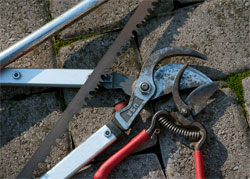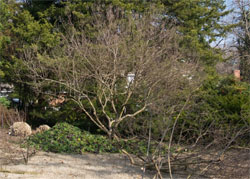Special Pruning Tips from Neil Sperry
Let’s condense the topic of pruning down to a few basic topics. We’ll call them "The Five ‘T’s of Pruning Success."

Pruning saw, lopping shears and hand shears are just part of a pruner’s collection of tools.

Peaches pruned in mid-winter show characteristic bowl-shaped branching.

Vitex pruned in mid-winter should be ready for vigorous early spring growth and late spring flowering.
Tools. You’ll need a handful of basic pruning tools. Start with hand shears. Anvil types (one cutting edge, one flat edge) cut larger twigs and they’re more durable than bypass shears (two cutting blades), but they can crush delicate plant tissues. You probably ought to have one pair of each for various types of trimming. Lopping shears, with the leverage of their long handles, allow you to cut larger branches (up to 1/2-inch in diameter). Use a long-handled pole pruning saw and pruning head for tall branches. Hand pruning saws are critical for branches 1 to 3 inches in diameter, and you’ll want a chain saw for anything larger than 3 inches in thickness. You may want hedge shears, either hand or power, for formal pruning.
Timing. Prune evergreen shrubs and trees, shade trees, summer-flowering shrubs and vines (crape myrtles, vitex, trumpetcreeper, althaeas, etc.), fruit trees (particularly peaches, plums and grapevines) and groundcovers in January or early February (and lightly as needed during the growing season). Prune spring-flowering shrubs and vines, also climbing roses, immediately after they finish blooming. Blackberries are pruned immediately after they finish producing fruit in early summer. Canes that have just borne fruit are removed clear to the ground.
Techniques. The old theory was that we should always prune branches flush with a remaining limb or trunk. That advice still applies to a degree, but we’re now told that the wound will heal more quickly if a 1/8-inch branch "collar" is left against the surviving branch or trunk. The tissue that grows across the wound forms out of that branch collar. Above all, never leave stubs that could decay back into the branch and even the main trunk. That means that "topping" trees will always be taboo for that exact reason.
Tricks. Professional arborists use what they call the 3-step approach to removing longer, heavier branches (3 inches in diameter and larger). If you simply start cutting these big branches, they will often break, pulling bark loose down the trunks, and doing severe damage to the trees. Step 1 is to make an undercut from beneath, one-third of the way up into the branch and some 15 to 18 inches out from the trunk. Step 2 is to move 4 or 5 inches farther out on the branch, then cut down all the way through. As the weight of the branch pulls it down, it will peel back only to the undercut. Step 3 is to remove the remaining stub back to the branch collar.
A second trick, when pruning shrubs, is to prune one branch at a time, cutting back into the body of the shrub’s canopy at varying places. That way you’ll leave foliage on the outside of the plant to conceal the cut surfaces. Long-handled lopping shears do the best job of this selective pruning. It will take a little longer, but the results will be far better.
Pruning sealant, surprisingly, may not always be a good thing. Research of the past 10 or 15 years has shown that wounds often heal faster when sealant is not applied. New growth "rolls" in from the outsides of the wounds, and that growth is retarded when pruning sealant is applied. If you decide to use the pruning paint, as you should for all oak pruning, for example, leave a thin line (1/4-inch or less) of raw wood around the outer edges of the cut surface.
Troubles. Sometimes we find that we have a plant that is simply too large for its surroundings. We wonder if pruning could be the solution, and generally that’s not the case. We should use pruning as a means of correcting erratic growth, rather than as a means of controlling height. That’s why you don’t want to "cut crape myrtles back," and it’s why you don’t want huge plants like redtip photinias under low windows. Move the offending plants to larger surroundings (or discard them), then replace them with more compact types.
Finally, there are times when you end up with really narrow branch angles. Those limbs are subject to breakage in wind and ice storms. You may be able to prune and remove them, or you may need to hire a professional arborist to counter-brace them to one another using all-thread eye bolts and heavy cable.

